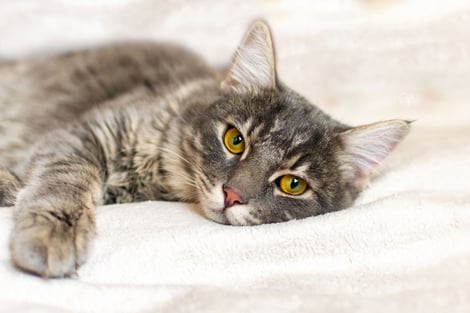Healthy Felines: Recognizing Common Cat Health Problems

Cats are generally healthy creatures. But they aren’t the best at letting us know if they are experiencing pain or discomfort. And when you do notice something is obviously wrong, sometimes a problem has been going on a lot longer than you may think.
In fact, sometimes they literally hide when they are in pain. So if your kitty is out of sight, you’ll want to check up on them and watch for telltale signs that something might be wrong.
For example, if you see that there’s a spot of vomit or pee/poop outside the litter pan, your cat might have a health issue.
Because many common cat health problems are preventable or easily addressed by veterinarians, it’s always a good idea to catch health issues early before they get worse.
If you are living with a companion cat (or several), what are some signs that your cat might be experiencing a health problem?
Signs Your Cat Might Need to See a Vet
- Lumps or bumps you haven’t noticed before
- Excessive or frequent scratching of ears or other body parts
- Changes in their energy level
- Limping or changes in how they walk
- Peeing and/or pooping where they're not supposed to (when they used to know)
- Drinking more or less water than they usually do
- Eating things they shouldn't eat (See our previous blog post on toxic foods for dogs and cats)
- Skin problems/hair loss
- Vomiting/hairballs
- Diarrhea
- Bad breath (see our post on pet dental health)
- Breathing funny
- Excessive grooming
- Unusual noises
- Changes in body shape or weight
If you notice any of these things, contact your veterinary care team and make an appointment. If you’re in doubt, call. They might tell you to come in as soon as possible, or they might recommend that it can wait until the next routine visit, depending on the details you provide.
8 Common Cat Health Problems You May Notice
We’re not trying to teach you to be veterinarians, because that would take too long (see our blog post about becoming a veterinarian). However, if you are curious about what different signs you should notice in your cat that could indicate a health problem, then read more below.
A veterinarian has been trained and licensed to know how to diagnose and treat a problem, so they will ask you questions about what signs you’ve been noticing. Otherwise, it’s best to try not to diagnose and treat a problem on your own. You will likely be charged a fee for the veterinarian to perform a physical exam, plus any diagnostic tests that are needed to find out what the problem may be, and any treatments that they recommend.
- Hairballs. Vomiting and hairballs are two different problems, but many people confuse the two. They both involve your cat making an icky retching sound and bringing up something disgusting. To the trained eye, hairballs look like long strings or tubes of hair. These are formed when cats groom themselves and their rough tongues catch their fur and they swallow it. If the hair passes through their body, no problem. But hairballs can be a real problem. “Coughing up a hairball” is not pleasant for you or your cat.
Ask your veterinarian what you can do to prevent hairballs from developing in the first place. And hairball blockage is a serious issue. If your cat is making gagging or hacking sounds and no hairball comes up, and if they are lethargic, constipated, have diarrhea or lack of appetite, you should call your vet’s office to make an appointment. - Vomiting. Many things can cause a cat to vomit. This looks different than a hairball. It can look clear or have a color to it, there can be food in it, or something else that they ate. Sometimes they may look like they want to vomit, and nothing comes out of their mouth. If your cat is vomiting a lot or too frequently, they can become dehydrated.
So it’s a good idea to contact a veterinarian and bring in a sample of the vomit, if possible, or take a picture of it on your phone to share with your veterinarian (I’ve done that). - Peeing outside the litter pan. If your cat is peeing someplace they shouldn’t, or if it looks like their peeing is painful or difficult when they’re trying to pee, it could be a serious health problem and a sign of stress. The following signs might mean your cat needs veterinary care:
-Peeing a lot, but only a small amount every time
-Peeing outside the litter box
-Straining while peeing
-Meowing while peeing
-Licking their bottom a lot more than usual
-Blood in the urine (this can look pink, red, or brown) - Diarrhea. If your cat has loose, watery, or liquid poop, it could be caused by many different things, which can be diagnosed by your veterinarian.
To prevent your cat from becoming dehydrated, offer lots of clean water and hold them back from eating for up to 12 hours. If they are still having a problem with diarrhea or other symptoms, call your veterinarian for an appointment. - Eye issues. There are a number of eye problems that cats experience, and some might indicate more serious issues. In general, talk to a veterinarian if your cat has
-Watery or cloudy eyes
-Tear‑stained fur
-Redness or goop around the eyes
-Squinting, pawing at their eye, or if you can see their third eyelid, which is normally hidden - Fleas and related parasites. Fleas are common and treatable. Signs your cat has fleas include flea dirt (tiny black dots, which indicates flea poop), scratching, licking, irritated skin, hair loss, or skin infection. Often you can see the fleas on your cat if they are heavily infested.
Remember that fleas are only on the cat for a blood meal. Otherwise, they like to hang out in places where your cat likes to sleep, like rugs, carpets, and other soft bedding. Even if you don’t see a flea on your cat, your cat can still have fleas and get “flea bite dermatitis” so bad that there is no fur left on the cat. If untreated, fleas can cause severe blood loss, so you’ll want to talk to a vet about treating fleas if your cat has them.
Better yet, keep your cat on a preventative to keep the buggers away in the first place. Tapeworms are parasites that grow inside the small intestine after a cat ingests a flea. If your cat is vomiting, losing weight, or has small white worms that look like grains of rice near their butt, that’s probably a sign your cat needs to be treated for parasites. - Ear issues. Cats usually show us they are having ear problems by scratching or shaking their heads. Some of the most common ear problems are ear mites, little parasites that are easily passed among cats and more common in cats that go outside. If your cat’s ear has little black chunks in it, or white specks, it’s probably mites.
There are over‑the‑counter remedies, but your vet can help you get a handle on this problem. If the ears are red or swollen, it could be a bacterial, yeast, or fungal infection. If your cat is shaking their head, rubbing their ears, or seems off balance, they might have a middle or inner ear infection. Talk to your vet! - Dental issues. It’s not easy to get a look inside a cat’s mouth to determine if they are in pain from tooth or gum issues. And many dental problems are below the surface. That’s why vets always do their best to check for signs of dental disease. If your cat is preferring canned food over kibbles, don’t assume they’re being a jerk. They might be trying to tell you something hurts. And bad breath can be a sign of dental disease.
Cat‑Friendly Veterinary Practices
Few cats enjoy going to the vet, but getting regular checkups at least once a year and staying up‑to‑date on vaccinations and parasite control is key to a long, healthy life.
Some veterinarians go the extra mile to make cats comfortable going to the vet. Cat Friendly Homes is a site that certifies veterinarians as having “cat‑friendly practices.” They try to minimize stress by using Feline Friendly Handling Guidelines, having cat‑only waiting rooms, and being alert to signs of feline stress.
With some planning and loving care, your cat will be able to live healthily and happily for all 9 lives.

